Erik Lindahl
Erik Lindahl
Erik Lindahl
Create successful ePaper yourself
Turn your PDF publications into a flip-book with our unique Google optimized e-Paper software.
Protein Physics 2012 Lecture 2, January 19<br />
Electrostatics and<br />
other interactions in<br />
proteins & water<br />
<strong>Erik</strong> <strong>Lindahl</strong><br />
CBR<br />
erik@kth.se<br />
Theoretical & Computational Biophysics<br />
Center for Biomembrane Research
Recap<br />
• Amino acids, peptide bonds<br />
• Conformational space for a chain<br />
• Φ,Ψ torsion, Ramachandran diagrams<br />
• Anfinsen’s hypothesis<br />
• Levinthal’s paradox<br />
• Secondary structure elements<br />
• Simple electrostatics, hydrogen bonds
Natural amino acids
Amino acid properties
α R<br />
β<br />
α L
Amino acids & structure<br />
• All amino acids are not equal<br />
• Proline is very rare in alpha helices<br />
• Glycine is common in tight turns<br />
• Some residues common at helix ends<br />
• Differences inside/surface of proteins<br />
• What is the cause of these differences, and<br />
can it be useful?
Outline today<br />
• More on interactions, charges & electrostatics<br />
• Hydrogen bonds<br />
• The peptide group/bond properties<br />
• Boltzmann distribution<br />
• Why is it so hard to keep your kids’ rooms tidy?<br />
• Definitions of entropy, temperature, etc.
Electrostatic strength<br />
Electrostatic interactions decay as 1/r (slow!)<br />
Example interaction energy:<br />
Two charges separated by ~1Å: 330 kcal/mol!<br />
(Compare to bond rotation, 2-4 kcal)
Semi-Empiric Modeling<br />
• Use simple interactions, but fit them to<br />
reproduce experimental properties<br />
• Compare to Ab initio: Use physics, and<br />
extrapolate 10-15 orders of magnitude<br />
• Arieh Warshel, Shneir Lifson,<br />
Michael Levitt
Partial charges<br />
0.41<br />
-0.82<br />
+0.41<br />
-0.82<br />
+0.41<br />
Approximation!<br />
-0.82<br />
+0.41<br />
Electron clouds are mobile, with density<br />
varying between different atoms!
Bond stretching<br />
• Vibration around<br />
average bond length<br />
• Reality: QM oscillator<br />
• Empirical description:<br />
Morse bond potential
Angle vibrations<br />
Similar to bonds:<br />
Should really be a<br />
QM oscillator, but can<br />
be approximated well<br />
Not quite as rigid as a<br />
bond, but almost
Torsions/dihedrals<br />
Frequently called<br />
“dihedral” angle too<br />
Angle between planes<br />
defined by atoms i-j-k<br />
Important! Gives rise to the<br />
& atoms j-k-l<br />
Ramachandran diagrams
Comparing torsions<br />
Ethane<br />
Butane<br />
Butane
Nonbonded interactions<br />
Packing effects<br />
(everywhere)<br />
Electrostatics<br />
(e.g. in water)
van der Waals interactions<br />
• Atoms repel each other at close distance<br />
due to overlap of electrons (repulsion)<br />
• All atoms attrach each other at long<br />
distance due to induced dipole effects<br />
(dispersion)<br />
Example - Buckingham potential:<br />
V (r)=Aexp Br + C 6<br />
r 6<br />
Same problem as before:<br />
exp(r) is slow to calculate
Lennard-Jones<br />
• Simpler form than Buckingham<br />
• In practice, atoms should never approach really<br />
close, so we just want a basic model of the<br />
repulsion<br />
• Smart trick: When we have calculated 1/r 6 , it is<br />
trivial to get 1/r 12 (1 multiplication)<br />
• Lennard-Jones potential<br />
V (r)=<br />
N<br />
Â<br />
i=1<br />
N<br />
Â<br />
j=1<br />
C 12<br />
r 12<br />
ij<br />
C 6<br />
r 6 ij<br />
!
Hydrogen bonds in proteins
Hydrophobic effect
Energy Landscapes?<br />
Bad?<br />
Good?
The Boltzmann Distribution<br />
⇢ / e<br />
E/kT
Formulating Boltzmann<br />
• Follow the book and derive it for<br />
a special case first: ideal gas in<br />
tall cylinder<br />
low<br />
density<br />
• Next week we do the real thing<br />
How many (N)<br />
molecules here?<br />
h<br />
Function of<br />
potential energy E!<br />
Gravity<br />
Pressure<br />
E(h)=mgh<br />
high<br />
density
Formulating Boltzmann<br />
• Clapeyron’s gas law: P=N k T<br />
• Potential energy (gravity): E(h)=m g h<br />
• dP/dh=(dN/dh)kT<br />
• dP=(m g N)(-dh)<br />
• dP/dh=(dN/dh)kT=-m g N<br />
• dN/dh=-(mg/kT) N<br />
• And use: (dN/dh) / N = d[ln(N)]/dh<br />
• d[ln(N)]/dh=-mg/kT<br />
• Integrate & take exponential of both sides<br />
• N ∝ exp{-m g h/kT} = exp{-E(h)/kT}
What does Boltzmann mean?<br />
• Probability of being at energy E A :<br />
pE A ∝exp{-E A /kT}<br />
• Compare with energy EB:<br />
pEA/pEB = exp{-EA/kT} / exp{-EB/kT}<br />
• Lower-energy states will be more<br />
populated<br />
• But is that everything?
Which shape is best<br />
energy-wise?<br />
Volume matters!
Free Energy<br />
• Introduce the available volume V A<br />
• Number of states proportional to volume<br />
• Thus, probability is proportional to volume<br />
• Consider probabilities of finding particles<br />
somewhere in volumes A vs. B:<br />
pVA/pVB = (VA exp{-EA/kT}) / (VB exp{-EB/kT})
Free Energy<br />
• Use V=exp{ln(V)}<br />
• This gives us:<br />
pVA/pVB =<br />
exp{-EA/kT+ln VA} / exp{-EB/kT+ln VB}=<br />
exp{-(EA-T*k ln VA)/kT}/exp{-(EB-T*k ln VB)/kT}<br />
• Looks just like a Boltzmann distribution?<br />
But now it says (E-T*k ln V) instead of E?
Entropy & Free Energy<br />
• Introduce Free Energy: F=E-T*k ln V<br />
• Entropy: S=k ln V (logarithm of #states)<br />
• F = E - TS<br />
• pA/pB=exp{-FA/kT}/exp{-FB/kT}<br />
• pA/pB=exp{-ΔF/kT}
How many states does<br />
this correspond to?<br />
1!<br />
How many similar<br />
states are there?<br />
few<br />
How many states does<br />
this correspond to?<br />
How many similar<br />
states are there?<br />
1!<br />
lots
Helmholtz & Gibbs<br />
• Free energy defines most stable state<br />
when system exchanges heat with<br />
surrounding environment<br />
• F is the Helmholtz Free Energy<br />
• Valid at constant volume<br />
• At constant pressure we have H=E+pV<br />
• Gibbs Free Energy G=H-TS=E+pV-TS<br />
• For proteins, pV is typically very small<br />
Physics: Usually Helmholtz<br />
Chemistry: Usually Gibbs Why?
Phase Transitions Explained<br />
• Systems wants to stay at lowest F<br />
• ICE: Low E, low low S<br />
• Water: Higher E, higher S<br />
• When temperature is low, first term (E)<br />
dominates F=E-TS<br />
• When temperature is high, second term<br />
(TS) dominates F=E-TS<br />
Much more on this later!
Thermodynamic T<br />
• Minor perturbations:<br />
• F->F+dF = F + dE - TdS - SdT<br />
• At equilibrium under constant V & T,<br />
this leads to:<br />
dF=dE-TdS=0<br />
• or: T = dE/dS (similarly T=dH/dS)<br />
• This is the thermodynamic definition<br />
of temperature!
Partitioning<br />
• Consider transfer of hydrocarbon to H 2 O<br />
• Concentrations (X) iso. probabilities<br />
• Count per mol, so R instead of k<br />
• X∝exp{-G/RT}<br />
• ∆Gliq->aq = -RT ln (Xaq/Xliq)<br />
• Free energies can be measured in lab!
Reality Check<br />
• Chapters 3 & 4 in “Protein physics”<br />
• Amino acids determine protein structure<br />
• Electrostatics & hydrogen bonds<br />
• Van der Waals / Lennard-Jones<br />
• Energy Landscapes<br />
• The Boltzmann Distribution<br />
• Free Energy<br />
• Do you understand entropy yet?


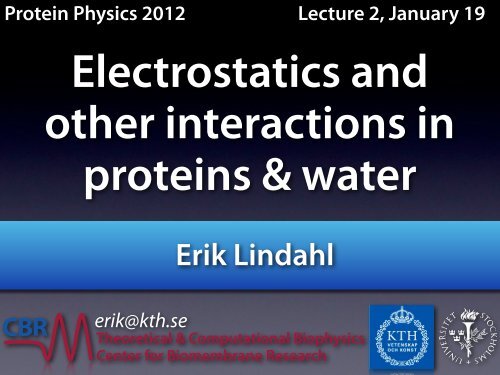
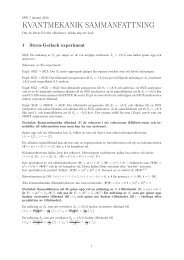

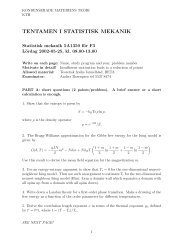
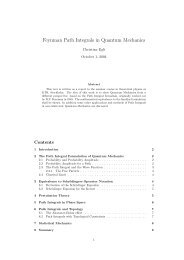
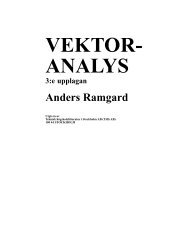
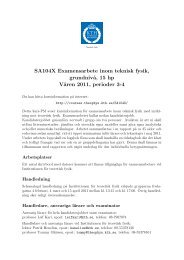

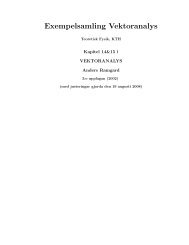

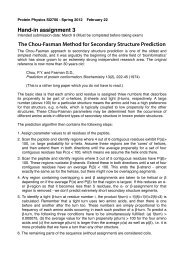

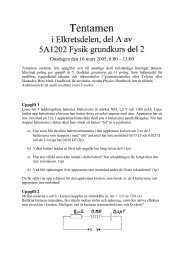
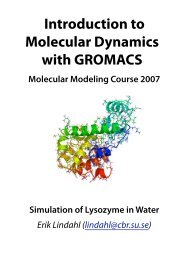
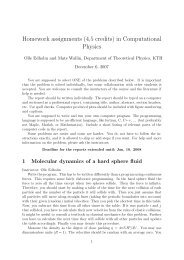
![[VAR]=Notes on variational calculus](https://img.yumpu.com/35639168/1/190x245/varnotes-on-variational-calculus.jpg?quality=85)